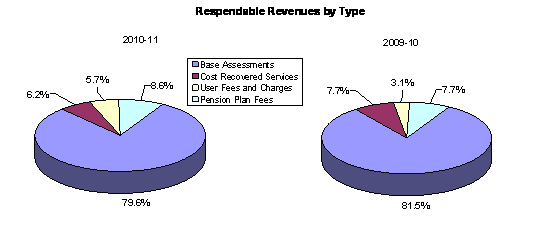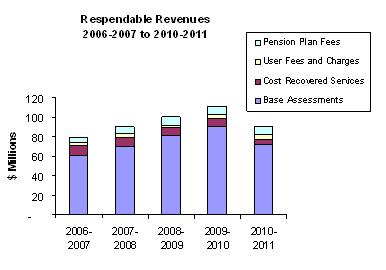Common menu bar links
Breadcrumb Trail
ARCHIVED - Office of the Superintendent of Financial Institutions - Supplementary Tables
 This page has been archived.
This page has been archived.
Archived Content
Information identified as archived on the Web is for reference, research or recordkeeping purposes. It has not been altered or updated after the date of archiving. Web pages that are archived on the Web are not subject to the Government of Canada Web Standards. As per the Communications Policy of the Government of Canada, you can request alternate formats on the "Contact Us" page.
Sources of Respendable and Non-Respendable Revenue
This table identifies revenues by program activity received from sources both internal and external to the government. For 2010-2011, OSFI’s total revenues were $90.2 million, excluding non-respendable revenue of $0.2 million for the collection of Late and Erroneous Filing Penalties. The respendable revenues are largely comprised of asset- or premium-based industry assessments, surcharge assessments to staged institutions, and user fees for specific services related to Regulatory Approvals.
Respendable Revenue
The table below illustrates sources of Respendable Revenue on a modified cash basis; however, OSFI recovers its costs through assessments and user fees billed on the accrual basis of accounting. The differences between the accounting methodologies give rise to fluctuations in revenues from year to year.
Commencing in the 2009-2010 Estimates cycle, the resources for the Internal Services program activity are displayed separately from other program activities; they are no longer distributed among the remaining program activities. Comparative figures for 2008-2009 have been restated to conform to the presentation adopted in 2009-2010.
As OSFI must fully recover its costs for all programs other than the Office of the Chief Actuary, which is partially funded by a parliamentary appropriation, respendable revenues in the Main Estimates were allocated to each program, including Internal Services, to match revenues to costs and plan spending at zero on a modified cash basis. When actual revenues are billed and received, an estimate is made to allocate a portion of this revenue to Internal Services. The difference in methodologies used to plan versus record actuals accounts for some of the variances between the Main Estimates and actual revenues in each of the program activities; as such, OSFI will continue to refine its methodology for allocating actual revenues between program activities during 2011-2012.
| Program Activity |
Actual |
Actual 2009-2010 |
2010-2011 | |||
|---|---|---|---|---|---|---|
| Main Estimates |
Planned Revenue |
Total Authorities |
Actual | |||
| (1) Regulation and Supervision of Federally Regulated Financial Institutions | ||||||
| Base Assessments | $0.0 | $0.0 | $51.0 | $51.0 | $51.0 | $43.8 |
| User Fees and Charges | $0.9 | $0.6 | $3.4 | $3.4 | $3.4 | $0.5 |
| Cost-Recovered Services | $0.8 | $0.5 | $0.2 | $0.2 | $0.2 | $0.2 |
| Subtotal | $1.7 | $1.1 | $54.6 | $54.6 | $54.6 | $44.5 |
| (2) Regulation and Supervision of Federally Regulated Private Pension Plans | ||||||
| Pension Plan Fees | $8.2 | $8.5 | $5.3 | $5.3 | $5.3 | $7.7 |
| (3) International Assistance | ||||||
| Cost-Recovered Services | $1.6 | $1.7 | $1.7 | $1.7 | $1.7 | $0.5 |
| (4) Actuarial Valuation and Advisory Services | ||||||
| User Fees and Charges | $0.1 | $0.0 | $0.1 | $0.1 | $0.1 | $0.1 |
| Cost-Recovered Services | $4.7 | $5.3 | $3.3 | $3.3 | $3.3 | $4.2 |
| Subtotal | $4.8 | $5.3 | $3.4 | $3.4 | $3.4 | $4.3 |
| (5) Internal Services | ||||||
| Base Assessments | $81.7 | $90.5 | $39.1 | $39.1 | $39.1 | $27.9 |
| Pension Plan Fees | $0.0 | $0.0 | $1.5 | $1.5 | $1.5 | $0.0 |
| User Fees and Charges | $1.6 | $2.9 | $0.0 | $0.0 | $0.0 | $4.6 |
| Cost-Recovered Services | $0.5 | $1.1 | $2.8 | $2.8 | $2.8 | $0.6 |
| Subtotal | $83.8 | $94.5 | $43.4 | $43.4 | $43.4 | $33.1 |
| Total Respendable Revenue | $100.1 | $111.1 | $108.3 | $108.3 | $108.3 | $90.1 |
The decrease in respendable revenues in 2010-2011 from the previous year is explained in the “Summary of Performance” and “Expenditure Profile” sections of this report. In addition, on the modified cash basis of accounting, OSFI had a lower inflow of funds than outflows than planned during 2010-2011. This is largely the result of higher accounts receivables driven by the later than usual billing of interim base assessments to the Life and Property & Casualty (P&C) industries for the current year, which explains the variances between 2010-2011 actuals and total authorities.

Total 2010-2011 respendable revenues were $90.1 million, a decrease of $21.0 million (18.9%) over the previous year’s total of $111.1 million. Base assessments of $71.8 million accounted for 79.6% of total revenue and represented a decrease of $18.8 million (20.8%) from the previous year. This decrease is attributed to the later than usual billing of assessments to the Life and P&C industries resulting in a significant increase in accounts receivable at as March 31, 2011.

Cost recovered services revenue was $5.6 million, down $3.0 million (34.9%) from the previous year, largely due to the termination of the Memorandum of Understanding (MOU) with the Canadian International Development Agency (CIDA) as a result of the cessation of OSFI’s International Assistance program activity in the first quarter of 2010-2011. User fees and charges were $5.1 million, up $1.6 million (45.7%) from the previous year while pension plan fees decreased by $0.8 million (9.4%) to $7.7 million. This was driven mainly by a decrease in the pension fee rate to $22 per member in 2010-2011 from $24 per member in the previous year.
Base assessments increased from 76.3% of total revenue in 2006-2007 to 79.6% in 2010-2011, while pension plan fees increased from 6.7% to 8.6% and User fees and charges increased from 4.7% to 5.7%. Cost recovered services decreased over the same period from 12.3% to 6.2% largely due to the expiry, on October 31, 2007, of the MOU with the large banks for the implementation of the internal ratings-based approach (IRB) of the New Capital Adequacy Framework (Basel II) and the expiry of the CIDA MOU noted above.
Non-Respendable Revenue
OSFI’s non-respendable revenues are entirely related to late and erroneous filing penalties. Effective 2002-2003, OSFI began collecting late and erroneous filing penalties from financial institutions that submit late and/or erroneous financial and corporate returns. On August 31, 2005 the Administrative Monetary Penalties (OSFI) Regulations came into force. These Regulations implement an administrative monetary penalties regime pursuant to which the Superintendent can impose penalties in respect of specific violations, as designated in the schedule to the Regulations. These Regulations incorporate the late and erroneous filing penalty regime and replace the Filing Penalties (OSFI) Regulations. These penalties are billed quarterly, collected and remitted to the Consolidated Revenue Fund. By regulation, OSFI cannot use these funds to reduce the amount that it assesses the industry in respect of its operating costs.
| Program Activity | Actual 2008-2009 |
Actual 2009-2010 |
2010-2011 | |
|---|---|---|---|---|
| Planned Revenue |
Actual | |||
| 1) Regulation and Supervision of Federally Regulated Financial Institutions | ||||
| Late and Erroneous Filing Penalties (LEFP) | $0.5 | $0.0 | $0.7 | $0.2 |
| Total Respendable Revenue | $0.5 | $0.0 | $0.7 | $0.2 |
The 2010-2011 Filing Penalty revenues of $0.2 million were lower than planned due to more timely and accurate filing of financial and corporate returns by financial institutions.
